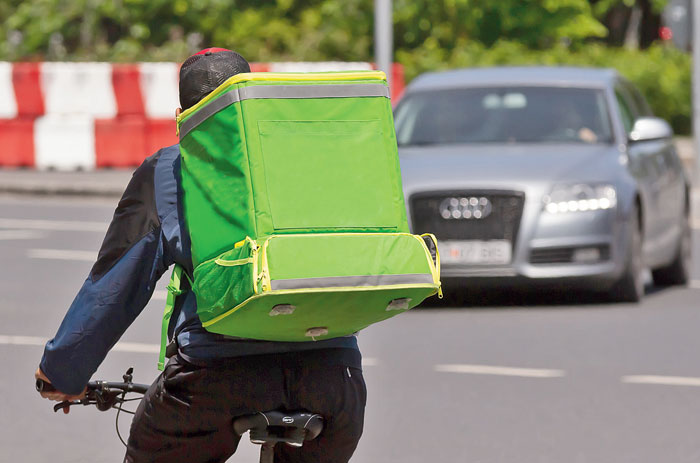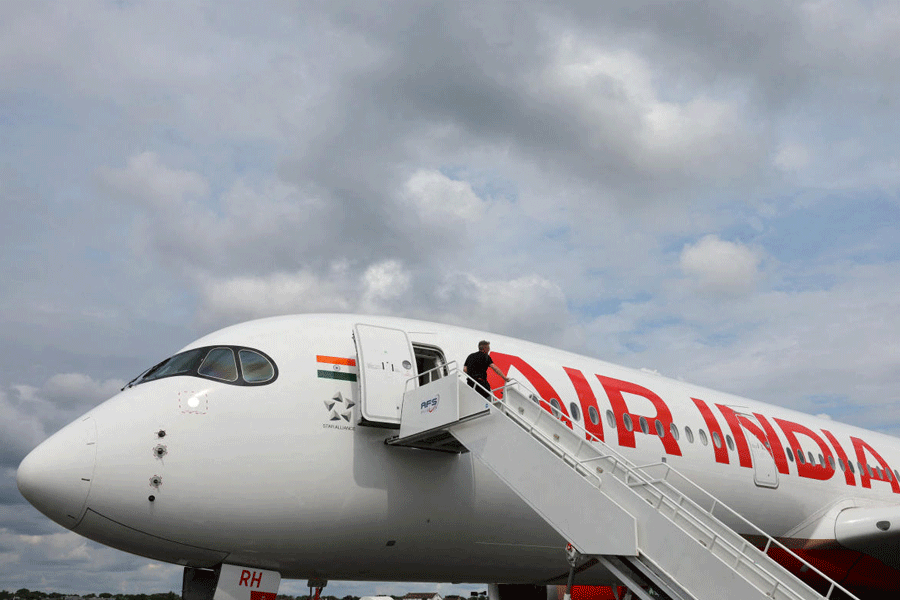Can there be a restaurant with no storefront, no tables and chairs, and no diners either? Apparently, yes. Call it ghost kitchen, virtual kitchen, dark kitchen or by the more popular term — cloud kitchen — it’s the phenomenon that has caught the attention of the food industry and changed its dynamics. The format relies on a well-equipped kitchen and delivery only, with no provision for dine-in facility. With many start-ups, established chefs, independent entrepreneurs, online aggregators and investors fighting for a piece of the pie, cloud kitchen is a phenomenon that many are referring to as the “future of the food industry”. t2oS digs deeper...
The C to K of Cloud Kitchen
In the simplest term, a cloud kitchen is a virtual restaurant that serves restaurant-quality food within the comfort of your home. “It’s a restaurant that delivers food but doesn’t serve food on location. The service is done by delivery people. Business generation typically happens through tech, usually through an app. The whole business of acquiring the customer is driven by tech,” said celebrated chef Sanjeev Kapoor who has a chain of restaurants across India and abroad, and is now in talks with investors to start cloud kitchens. “We have already started with pilots but haven’t really started talking about it. First is Bombay and then Bangalore,” said Kapoor.
For a cloud kitchen to exist, while the cost of real estate is low, you cannot rule out the importance of a good location. “It ideally should be close to neighbourhoods that have a demand for delivery-only food. What you spend on is rent, cost of manpower and raw materials. You then list yourself on aggregator apps and that becomes the storefront for you,” said celebrity chef Ranveer Brar who works extensively with Eat.fit, the food delivery arm of Cure.fit, a wellness start-up, and “loves” the cloud kitchen format.
Falling under the food service segment, the cloud kitchen format’s rise and demand is fuelled by the advent of OTT platforms, venture capital funded aggregators and a realisation that it’s a more economical way of doing business. “You don’t have to worry about 500 regulations, issues with cops, excise, complaining customers… it’s a simplified and economical format. You even have someone else doing the logistics for you,” said Manu Chandra. The chef partner of the Olive Group of Restaurants sees a possibility of creating parallel brands that operate only out of cloud kitchens as an attempt at staying relevant. Talking about the new paradigm, he said, “I think there’s an awareness of the fact that more and more people now want to sit at home and eat, rather than brave the traffic and issues that plague the big cities in India. It’s more economically viable for them. Now you Netflix and chill and eat food from a restaurant essentially, but in your home.”
Convenience, easy access, relatively low price points, variety, and lack of time and skill set to cook are some of the factors behind the popularity of the cloud kitchen format. “Since there’s no storefront and you don’t know where the food is coming from, what becomes essential in this format is the importance of packaging, branding, and most importantly, the quality of food that’s being served. These are the factors that help in establishing a brand when there’s hardly any recall value. In today’s day and age, it (establishing a cloud kitchen brand) isn’t that difficult. There are brands now that are built through digital medium only. But there has to be a strategy in place,” said Kapoor.
The chairman and managing director of Speciality Restaurants, Anjan Chatterjee pointed out one interesting aspect of this business model. “Since the entry barrier is so low, anybody can get into this space. And what becomes very important then is the source of the cloud kitchen, and hygiene. All our restaurant kitchens, by and large, are ISO 22000 certified,” he added.
Even though she thinks that cloud kitchen isn’t just a trend but a phenomenon which is here to stay, Karen Anand is not entirely warm to the idea. “I totally agree that less and less people are cooking because they don’t have the time, but I feel food isn’t just about eating, there’s a certain pleasure that you derive from the whole process of cooking and eating. Now if you are going to order in, there’s nothing wrong with it but I feel that the pleasure is gone. For me, life revolves around the pleasure of food. There’s a whole generation that doesn’t know how to cook and it’s not their fault because they probably haven’t been taught. Having said that, it (cloud kitchen) is the future of the food industry but I don’t see myself getting into this,” said the culinary consultant, food writer and entrepreneur.

iStock
Can we have a piece of the pie?
Upscale and established F&B brands, too, are riding the wave and foraying into the cloud kitchen space. With most of the restaurants already having a delivery model in place and a brand that’s synonymous with good food, the question here lies whether they have an added advantage over start-ups. “There will always be an added advantage for a brand because you have faith in an established brand. But for a new entrant, they have to build that trust. And in order to do that, they have to use social media and all the tactics which are available in the market to ensure that they are relevant. Of course, the product has to be up to the mark and consistent,” said Chatterjee. Chandra points out another reason why big brands are drawn to this format. “Fear of missing out, losing revenue and realising that numbers have changed are the reasons why established brands are entering this space,” he said. On the other hand, Kapoor said, “When it comes to established brands, they know that they have everything in place and it’s their core business, why shouldn’t they have a piece of the pie?”
Relevance is the key
For cloud kitchens, what often becomes a struggle is the need to stay relevant. Understanding what people want, keeping your social media game on point and focussing on experiential packaging are some of the areas that need to be focussed on. “You stay relevant by understanding what people are looking for, with the product being the most important part because your rating determines how you fare in the algorithm that’s set by the online aggregator. Apart from the product, it’s the packaging, how fun it looks, and the experience that comes with it,” said Brar.
Kapoor, who had invested in an once-existing mobile application-based food aggregator which was a marketplace and delivery service for home-cooked meals, thinks scalability is the key here. “If you are getting into this space, you have to think of coming up with 1,000 kitchens, because that’s when you will earn good money. Or else, manage a couple but do it wholeheartedly. There’s nothing in-between,” he added.

iStock
The enablers
What propelled the rise of cloud kitchens in the last two to three years are the online aggregators like Swiggy, Zomato and Uber Eats. Even restaurant brands that had or still have their own delivery service, find it easier to be listed on the aggregator platforms, with them taking care of delivery and the hassles that come with it. “With the advent of platforms such as Swiggy and Zomato, things have become easier. Restaurateurs were having a difficult time managing a logistics arm but slowly as they came in, things have become uncomplicated. The retail cost is going down,” said Chatterjee.
Apart from facilitating the process of delivering food, Zomato’s Zomato Kitchens and Swiggy’s Access Kitchens are helping fix gaps that exist in the system. While Swiggy launched Access Kitchens as a “strategic initiative to bring great quality food closer to consumers while enabling business expansion for its restaurant partners”, Zomato Kitchens was launched to “connect people with kitchen infrastructure”. “With our food delivery business being present across 400-plus cities in India, we realise that the food consumption behaviour of our country is changing and that the demand for food prepared outside the home kitchen is much higher than the supply that is currently available. With Zomato Kitchens, we are following a franchise model in which we connect people with kitchen infrastructure in different cities with restaurants looking to expand their presence following the cloud kitchen delivery model. We are helping restaurants expand and scale rapidly while incurring a minimal fixed cost, adding more supply in our delivery ecosystem and offering our users more and better food options,” said Mohit Sardana, COO food delivery, Zomato.
“The aim was to bridge geographical gaps in restaurant supply, thereby solving for variety, quality and convenience of food while enabling restaurant partners to expand to new neighbourhoods and attract more customers. Swiggy pioneered and successfully cracked this model that is now present in 12 cities with 400-plus restaurant partners, the largest in the country. In an industry first, Access is also enabling inter-city expansion for its restaurant partners. Madurai Idly Shop has successfully expanded from Bangalore to Pune through Swiggy Access. Similarly, Rang De Basanti from Calcutta has begun serving consumers in Bangalore,” said Vishal Bhatia, CEO, new supply, Swiggy.
But how do the online food aggregators earn revenue from such a model and bring in profitability? “The sole objective of Swiggy Access is to fulfil existing and future consumer gaps by taking some of the most loved brands to more consumers in our cities. Within the first three months of coming on Access, most of the restaurant partners have doubled the volume of their delivery side of the business. One in four partners have expanded to a second kitchen with Access, reinforcing their belief in the concept,” said Bhatia. He added that for each order Swiggy charges a a fixed percentage from restaurant partners for the kitchen infrastructure and other benefits provided. Over time, this reduces as the volume of order starts growing. “For Swiggy, Access contributes around 20 per cent to 25 per cent towards the overall business in the areas they operate out of,” he added.

iStock
Is cheap really cheerful?
One of the reasons for friction between chefs, aggregators and cloud kitchen operators that’s seeping into this model is the low price points and the world of discounts. “There’s this whole paradigm created where cheap is cheerful, which is fine. But what that does to competition is catastrophic because not everyone can hold up that kind of benchmark. So people who want to deliver good quality food realise that they can’t compete in that space. It boils down to one strata of delivery that’s successful, people who bank on economy of scale. People tend to go for the cheaper option. So, it’s going to push down the benchmark for sure. And that has already started happening,” said Chandra.
One more aspect that requires attention is whether the food that comes from the cloud kitchens are really as cheap as they are portrayed to be. “When you order restaurant-style food, you aren’t paying for the air conditioning, service and experience. So, in a restaurant let’s say you pay Rs 350 for a biryani, you are paying Rs 250 when you order from a cloud kitchen. In reality it should be much cheaper but the consumer mind sees a direct comparison there. So when people say that food from a cloud kitchen is cheaper, it is actually cheaper than restaurant food but they are still paying a premium, despite the incentives and discounts, if you look at the cost of food and conversion,” said Kapoor.
The success stories
Saransh Goila of the Mumbai-based Goila Butter Chicken won’t do anything differently if he has to start all over again. Reason being the tremendous growth that his venture has seen over the years. With his first kitchen in Mumbai’s Andheri that he started in 2016, Goila and his business partner now own five outlets across Mumbai. “It’s (cloud kitchen) low on investment, rentals are fairly cheaper and return on investment is higher. Target clientele is purely looking for good food. Our expertise is food and we can stick to that with this delivery model. It is the future of the F&B industry,” said Goila whose Goila Butter Chicken dish took him to MasterChef Australia as a guest judge in 2018.
Apart from using social media as a marketing tool, Saransh and his business partner also relied on traditional ways of marketing like pamphleting and door-to-door promotion. “We also invested a bit of the marketing budget on the online aggregators… pushed the brand out there so that people can discover us. Because for a cloud kitchen, it’s all about discovery. And of course, one thing that doesn’t change in this business is word of mouth. What I would advice the newcomers is that, have 20 per cent of your budget aside for marketing apart from having money in your account for operational expenses for at least six months because you have to assume that for six months no one is going to order anything,” said Goila.
One company that has changed the way we look at food delivery by creating a new food tech category way back in 2014, is Rebel Foods. Termed as “the world’s largest Internet restaurant company”, Rebel Foods is the brainchild of Calcutta-born and -bred Jaydeep Barman and Kallol Banerjee. “We were going through the pain of running brick-and-mortar chains... our rents were very high, our locations were risky. We went through all the trials and tribulations and wondered how we could create a better business. We did a survey among the customers and asked them whether they had seen our store and 74 per cent customers said that they hadn’t. We realised that in the new age it was okay to order food on the Internet. It was a calculated gamble we took and we started our first cloud kitchen in Bombay and we saw all the good things that came along with it. By 2015 end, we shut all our brick-and-mortar outlets,” said Barman.
Being the first player in any segment has an added advantage. It helps one in assessing the pitfalls and coming up with measures to counter them as well as gain customers before anyone else enters the market. Their Behrouz Biryani alone is a Rs 200-crore brand. Rebel Foods that has eight brands under its wing is set to expand in India and abroad. “We opened in Indonesia and are coming up in Dubai. There will be one in UK as well by the end of the year. In the next one year we should have 400 kitchens in India, with presence in Indonesia, Middle East and the UK and most probably Latin America,” added Barman.
He has a word of caution for entrepreneurs who want to foray into this space. “Two of the most important things in this business model are consistency and quality. You can have one kitchen where you are the chef and then you don’t need to worry about it. But if you were to put out 10 or 100 of those then how do you create a system where quality and consistency are never compromised? That system will have automation, standardisation, training, culture building. So having that system of maintaining quality and consistency is the biggest enabler.”
While the online aggregators charge a certain amount of money as commission, Goila and Barman feel that when it boils down to profits, the difference is negligible. “When we employ our delivery boys, they do only our delivery, so the per delivery cost is higher. While when we deliver through Swiggy or Zomato or Uber Eats, the per delivery cost is lower,” said Barman. Goila added, “Managing logistics take a toll... the headache of managing the delivery boys, paperwork…. I will probably dedicate that time on developing my products and doing more sale which will compensate for that slightly extra margin that I am losing out by listing my cloud kitchen on the online aggregator. ”

Picture: B. Halder
Calcutta kitchens
When Shantanu Sikdar of Kabuliwala, which is known for their Chicken Biryani among other Mughlai and Indian dishes, wanted to venture into the F&B industry, he realised that the cloud kitchen model was the way forward. “Back in 2016, the concept might have been new in Calcutta but in cities like Mumbai and Bangalore cloud kitchens had already been there for quite some time,” he said. For a bootstrapped company that delivers almost 1,200 to 1,500 orders on peak days, what worked was word of mouth. “Being the first movers, we did have some advantage but we also faced problems because it was such a new concept. Right from figuring out how to manage the supply chain, predict sales, manpower recruitment and training…,” said Shantanu. With a repeat order percentage of almost 70, not being visible never posed a threat to Kabuliwala, where the minimum cost of food is Rs 50. “Even though we aren’t visible anywhere we are still serving almost 45,000 patrons every month. This was only possible through word of mouth and digital marketing,” said Shantanu.
Listed on Swiggy and Zomato, Kabuliwala also has their own delivery fleet with 35 delivery boys. “Having your own delivery fleet is any day more cost effective, plus the service is way better because it’s more personalised. Having your own delivery fleet only requires lot of capital investment. That’s where the online aggregators come in and help us grow faster,” he said. By December 2020, Shantanu plans to have 20 satellite kitchens spread all across Calcutta.

Picture: B. Halder
For 25-year-olds Manila Nad and Radhika Kauntia of Mon Petite that sells customised cakes, choux pastry, tarts, brookies, ice creams and breads, with their bestseller being profiteroles, the reason for starting a cloud kitchen was to “try” the market and come up with good quality products. After training in baking, they came up with a 500sq ft cloud kitchen in Ballygunge. With price starting at Rs 180, Mon Petite isn’t yet listed on online aggregator apps and are running their business the traditional way through phone calls, social media promotions and word of mouth.

Picture: B. Halder
Husband and wife duo Sneha Mirchandani and Adhiraj Mukherji of The Mighty Slice, that specialises in single-serve
11-inch pizzas, are newbies in the industry who are banking on online aggregators for their business growth. With a background in website designing and social media marketing, it was Sneha and Adhiraj’s love for cooking, particularly making pizzas, that made them start this venture — a bootstrapped company with a 120sq ft kitchen on Keyatala Road. “We had this idea for almost two years. I used to make a lot of pizzas at home, trying different recipes, and different types of hydration. End of last year is when we decided to give it a go and in April this year we decided to go live on Swiggy and Zomato,” said Adhiraj who takes pride in his “premium quality” Pepperoni, Enough Said pizza which also happens to be a bestseller. With both non-vegetarian and vegetarian options available, the minimum cost of a pizza is Rs 177.
They feel having limited options on the menu helps them to monitor and control their products and being listed on aggregator apps help them reach out to more customers. “Even though we give a certain amount (of money) as commission, what they give in return is massive. You are listed on an app where the chances of discovery are higher. We know how difficult it is to reach out to the right person,” said Sneha. The Mighty Slice also has its own website that goes by the same name.










